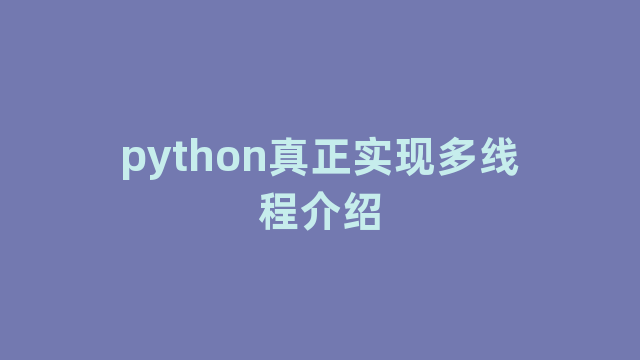
最开始学习多线程时候,小编看着就很头疼,复杂的逻辑运算,各种函数方法,不同的调用,让人身心俱疲,然而针对这部分,小编给大家带来了可以系统了解多线程,,理解上非常简单,使用上非常便捷,大家可以看下面内容。
关于多线程
python提供了两个模块来实现多线程thread 和threading ,thread 有一些缺点,在threading 得到了弥补,为了不浪费你和时间,所以我们直接学习threading 就可以了。
继续对上面的例子进行改造,引入threadring来同时播放音乐和视频:
#coding=utf-8 import threading from time import ctime,sleep def music(func): for i in range(2): print "I was listening to %s. %s" %(func,ctime()) sleep(1) def move(func): for i in range(2): print "I was at the %s! %s" %(func,ctime()) sleep(5) threads = [] t1 = threading.Thread(target=music,args=(u'爱情买卖',)) threads.append(t1) t2 = threading.Thread(target=move,args=(u'阿凡达',)) threads.append(t2) if __name__ == '__main__': for t in threads: t.setDaemon(True) t.start() print "all over %s" %ctime() import threading 首先导入threading 模块,这是使用多线程的前提。 threads = [] t1 = threading.Thread(target=music,args=(u'爱情买卖',)) threads.append(t1)
创建了threads数组,创建线程t1,使用threading.Thread()方法,在这个方法中调用music方法target=music,args方法对music进行传参。 把创建好的线程t1装到threads数组中。
接着以同样的方式创建线程t2,并把t2也装到threads数组。
for t in threads: t.setDaemon(True) t.start()
最后通过for循环遍历数组。(数组被装载了t1和t2两个线程)
setDaemon()
setDaemon(True)将线程声明为守护线程,必须在start() 方法调用之前设置,如果不设置为守护线程程序会被无限挂起。子线程启动后,父线程也继续执行下去,当父线程执行完最后一条语句print “all over %s” %ctime()后,没有等待子线程,直接就退出了,同时子线程也一同结束。
start()
开启线程活动,运行结果:
>>> ========================= RESTART ================================ >>> I was listening to 爱情买卖. Thu Apr 17 12:51:45 2014 I was at the 阿凡达! Thu Apr 17 12:51:45 2014 all over Thu Apr 17 12:51:45 2014
从执行结果来看,子线程(muisc 、move )和主线程(print “all over %s” %ctime())都是同一时间启动,但由于主线程执行完结束,所以导致子线程也终止。
继续调整程序:
... if __name__ == '__main__': for t in threads: t.setDaemon(True) t.start() t.join() print "all over %s" %ctime()
我们只对上面的程序加了个join()方法,用于等待线程终止。join()的作用是,在子线程完成运行之前,这个子线程的父线程将一直被阻塞。
注意: join()方法的位置是在for循环外的,也就是说必须等待for循环里的两个进程都结束后,才去执行主进程。
运行结果:
>>> ========================= RESTART ================================ >>> I was listening to 爱情买卖. Thu Apr 17 13:04:11 2014 I was at the 阿凡达! Thu Apr 17 13:04:11 2014 I was listening to 爱情买卖. Thu Apr 17 13:04:12 2014 I was at the 阿凡达! Thu Apr 17 13:04:16 2014 all over Thu Apr 17 13:04:21 2014
从执行结果可看到,music 和move 是同时启动的。
开始时间4分11秒,直到调用主进程为4分22秒,总耗时为10秒。从单线程时减少了2秒,我们可以把music的sleep()的时间调整为4秒。
.. def music(func): for i in range(2): print "I was listening to %s. %s" %(func,ctime()) sleep(4)
执行结果:
>>> ====================== RESTART ================================ >>> I was listening to 爱情买卖. Thu Apr 17 13:11:27 2014I was at the 阿凡达! Thu Apr 17 13:11:27 2014 I was listening to 爱情买卖. Thu Apr 17 13:11:31 2014 I was at the 阿凡达! Thu Apr 17 13:11:32 2014 all over Thu Apr 17 13:11:37 2014
子线程启动11分27秒,主线程运行11分37秒。
虽然music每首歌曲从1秒延长到了4 ,但通多程线的方式运行脚本,总的时间没变化。
好了,大家可以通过以上内容,就可以系统的使用python多线程了奥。
神龙|纯净稳定代理IP免费测试>>>>>>>>天启|企业级代理IP免费测试>>>>>>>>IPIPGO|全球住宅代理IP免费测试





